Turnitin similarity report in Inspera (Original)
Turnitin is a similarity reporting tool that is available in the Inspera Assessment platform. You can request similarity reports directly within the grading tool (i.e. when marking). This guide will provide you with information on Turnitin, along with step-by-step instructions on activating it within your test.
Similarity reports are available for the following Manually marked question types:
- Essay by Inspera
- Upload Assignment by Inspera
Note: TurnItIn will accept any file that is less than 100MB, has a minimum of 20 words, and is less than 800 pages.
Request Similarity Report
Request Similarity Report as Planner
As the Planner of a test, you can request similarity reports on all candidate submissions. This is done in the test creation phase (in Deliver), and the reports will be ready for the grader(s) once they start grading.
- Set up a test in the Deliver module.
- Under Options, select the Security drop-down and click Request Similarity report.

- Finish creating the test with your desired settings.
Note: If you apply a template to the test you create, the setting Request Similarity report has been selected by default.
Refer to the Inspera Test settings guide (Step 12) for detailed instructions.
Request Similarity Report as Grader
If the Planner has not requested similarity reports in the preparation phase, no reports will be available when opening the Similarity check tab. The grader can click Request report under the Similarity check tab of a candidate's submission, and the report is generated.
- Navigate to the relevant question.
- Click on the Similarity N/A button.
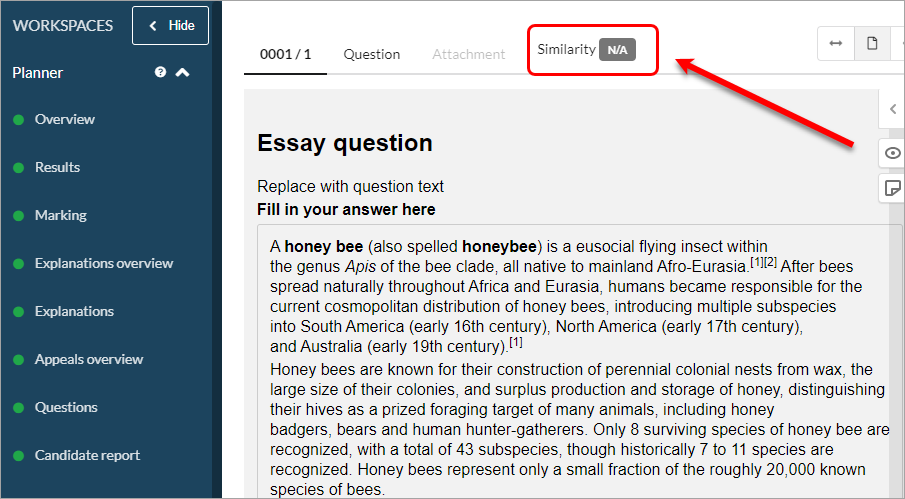
- Click on the Request report button.
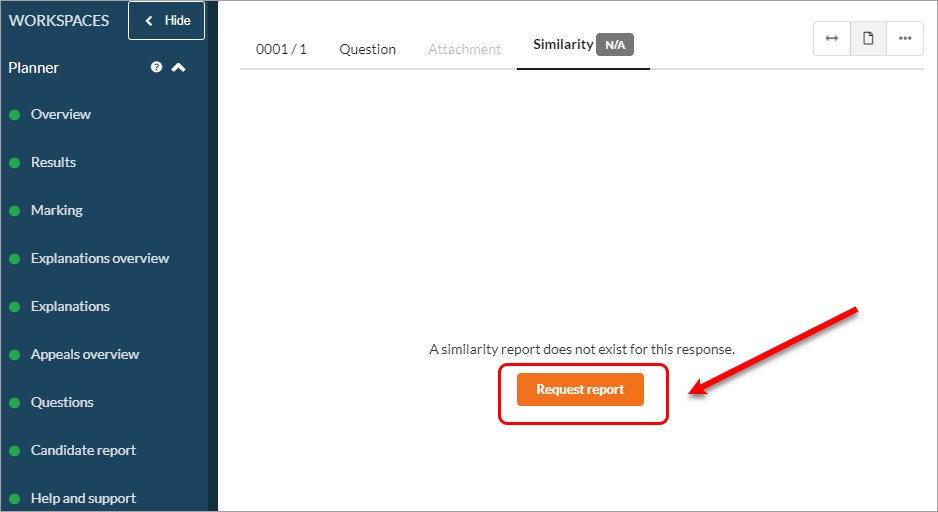
- The waiting message will be displayed. If the wait time is abnormally long, click on the Refresh button.
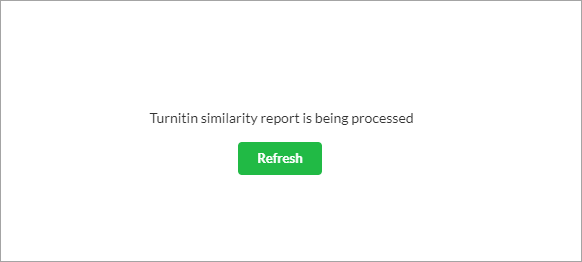
- The Similarity report will be available for viewing.

View Similarity Report
Note: It will take up to 15 minutes after the test closes before a similarity report is published.
For both Planner and Grader roles, the Similarity Report can be viewed from:
- from the Overview tab in Grade Workspaces, or
- from the response you are marking
View Similarity Report from Overview
- Access your test for marking
- The Overview tab will be displayed.
- Click on the Similarity score you want to view. Note: The similarity scores are coloured by the level of matching. For instance, the 50 per cent is coloured orange.

View Similarity Report from student's response
- Access your test for marking
- Click on the Marking tab in workspaces.
- Navigate to a manually marked question.
- Click on the Similarity tab.

Note: the response displays student ID (s46xxxxx) and question number 21.
Investigate the Similarity of student's response
- The response with similarity matching will be displayed.
- Optionally:
- You can view additional information such as matching text, top matching source list, and additional source information and adjust the similarity report filters.
- Click the cog button for settings where you can exclude search repositories, and exclude from similarity report.
- Click the question mark icon for a tour of the workspace.
- Click on the similarity score to view the details
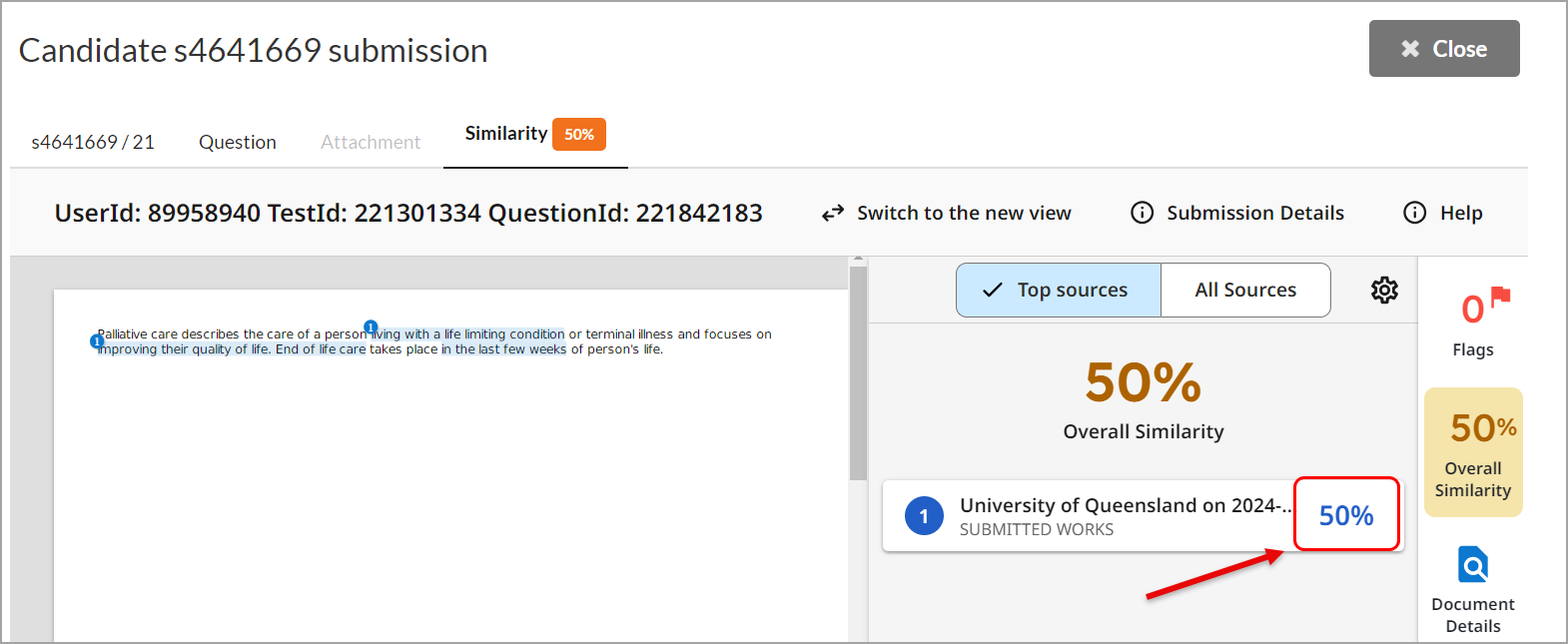
- The source text that contains the matching will be displayed with highlights.
- Click on the Details button to view further information on the source text.
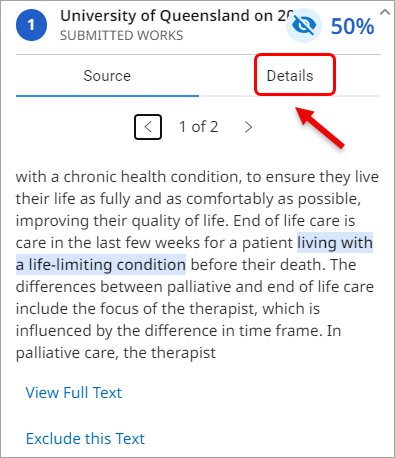
- This example is the case of an exam, so the text was matched with another student's submission.
- Source text details, therefore, are displayed with Student ID, name, email address.
- Optionally, you can search for the student/owner of the source text:
- Copy the student ID (s47xxxxx).
- Click on the Close button.
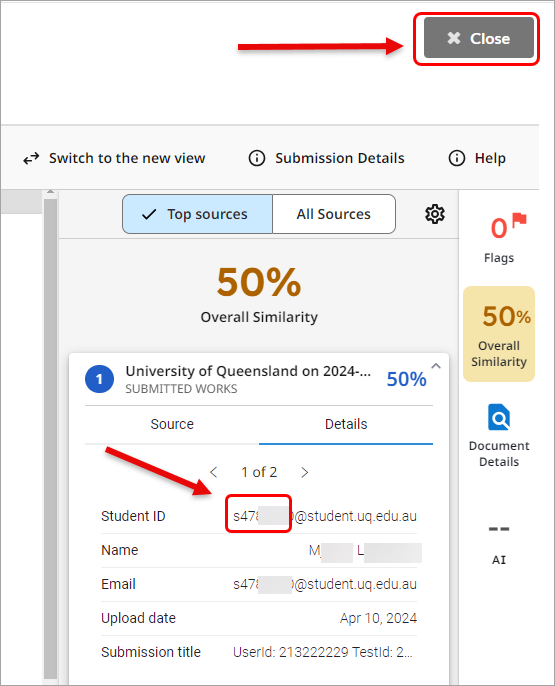
- Click on the Overview tab.
- Paste the student ID on the search box.

- The student in search will be displayed.
- Click on the Marking tab.

- The student's response (the source text - ID s47xxxxx) will be displayed (Question 21).
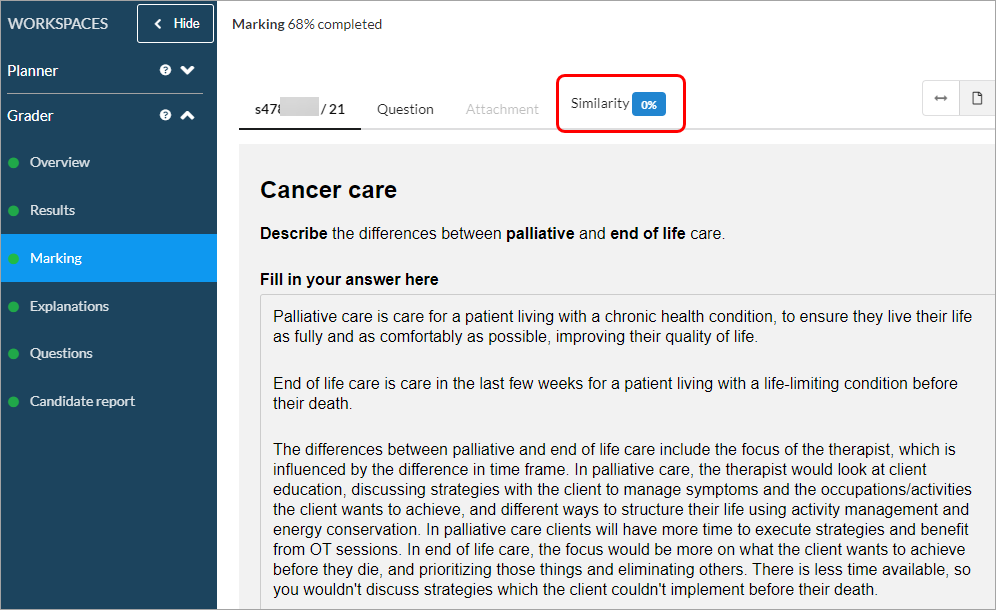
Note: In this example, even though the matching score is high (50%), the response is quite short and the matched texts show the common phrases in the course contents. That explains the normal similarity matching rather than any collusion or cheating.
- Academic Integrity & Assessment Security in Inspera
- Access Inspera
- Access your Inspera test for marking
- Add graders to an Inspera test
- Add media content to questions in Inspera
- Add one-time users to an Inspera test
- Add the Assumption and Queries question in an Inspera exam
- Adding Resources (pdf files, links) to a Question Set
- Adding staff (contributors) to an Inspera assessment
- Adding the Academic Integrity Statement to your assessment
- Additional pages required for Inspera exams
- Alternative method for downloading Final Marks from Inspera
- Answer key corrections - MCQ
- Apply Alternative Exam Arrangements (AEAs) and Time Zone Adjustments in Inspera
- Assign questions to graders in Inspera
- Complete an Inspera test as a student
- Confirm grades in Inspera
- Copy a question set from Inspera Training to Inspera Admin (Original)
- Create Inspera practice exam with Safe Exam Browser
- Create an Inspera submission link in Learn.UQ
- Create an Inspera test in Deliver
- Create bands and criteria
- Create marking committees in Inspera
- Create marking committees using CSV
- Creating Questions
- Downloading responses to Assumptions and Queries
- Edit question weight in Inspera
- Enable After-test settings in Inspera
- Enrol students in Inspera test using CSV file
- Explanations on student responses
- Export questions from Blackboard to Inspera (Original)
- Exporting a Question Set to PDF
- False Start
- Filter functionality in Inspera marking
- Flag students in Inspera test
- Getting started with Inspera
- Grading workflow for Planners and Graders
- Incident Adjustments for students who experience technical delays
- Inspera Assessment Design Settings
- Inspera Assessment Environments and their Purposes
- Inspera Assessment User Roles
- Inspera Assessment access methods for students
- Inspera Exam Requests
- Inspera Grade Workspaces
- Inspera Observed User Testing
- Inspera Question Set Version Control
- Inspera Recommended Assessment - Standard (non-exam) assessment - webpage
- Inspera Rubrics
- Inspera School-based Exams
- Inspera Test settings
- Inspera analytics
- Inspera central on-campus and non-invigilated exams (Original)
- Inspera marking navigation
- Inviting students to an assessment via Test Code
- Late submissions and extensions in Inspera Assessment
- Manually marked questions: Mark and feedback
- Monitor Assessment
- Name and label questions in Inspera Assessment
- Navigate Inspera
- Override scoring of questions in Inspera
- Pilot an Inspera assessment
- Question sets in Inspera Assessment
- Sections in Question Sets
- Sharing a question set in Inspera Assessment
- Student Arrives Late
- Supporting students to use Inspera Assessment
- Things to look for in review
- Transfer results from Inspera to your Learn.UQ course
- Turnitin similarity report in Inspera
- View student responses in Inspera
